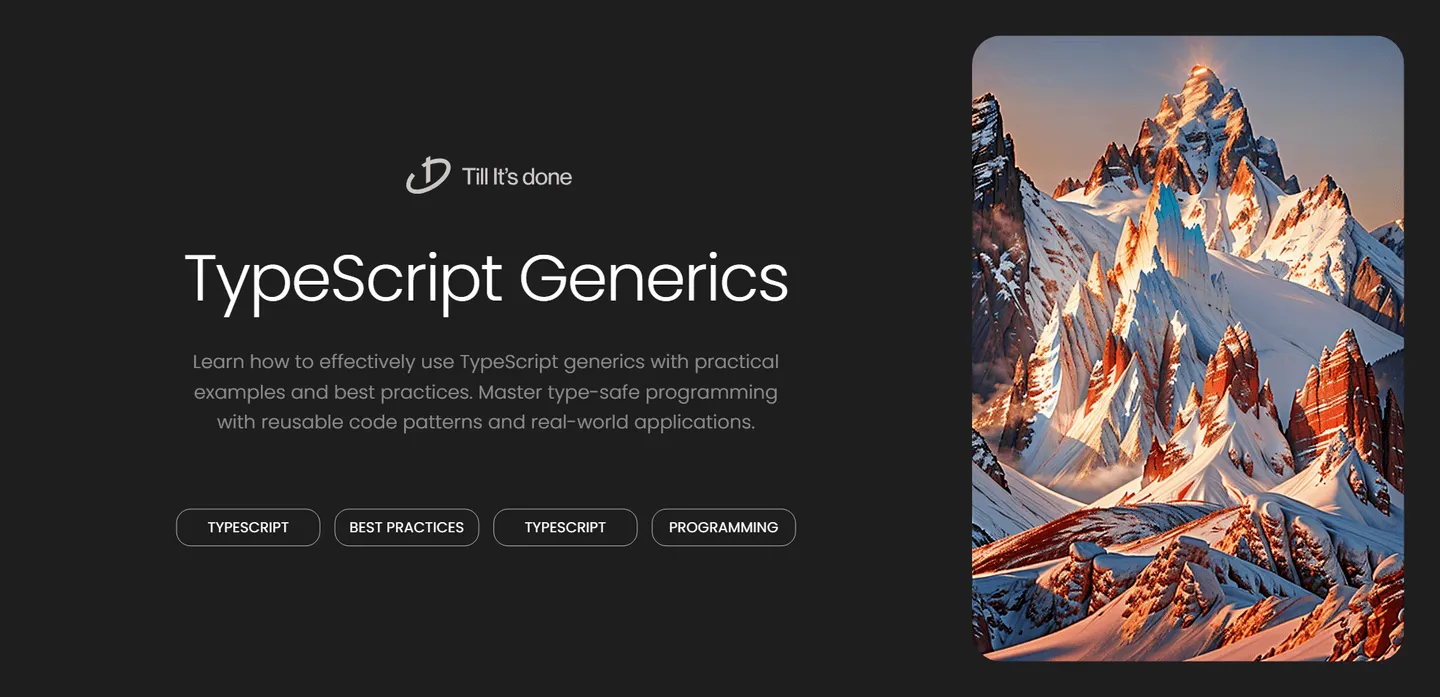- Services
- Case Studies
- Technologies
- NextJs development
- Flutter development
- NodeJs development
- ReactJs development
- About
- Contact
- Tools
- Blogs
- FAQ
Using Generics in TypeScript: Best Practices
Master type-safe programming with reusable code patterns and real-world applications.

Using Generics in TypeScript: Best Practices and Examples

Diving into TypeScript’s generics might seem daunting at first, but they’re like having a Swiss Army knife in your coding toolkit. Let’s break down this powerful feature and explore how to use it effectively in your projects.
Understanding the Basics
Think of generics as placeholders for types that you’ll specify later. It’s like telling TypeScript, “Hey, I’ll let you know what type I want to use when I actually use this code.” This flexibility makes your code more reusable and type-safe.
function identity\<T\>(arg: T): T { return arg;}
// Using itconst numberResult = identity(42); // Type is numberconst stringResult = identity("Hello"); // Type is stringReal-World Use Cases
Creating Type-Safe Collections
One of the most common uses for generics is building type-safe collections. Here’s how you might create a simple queue:
class Queue\<T\> { private data: T[] = [];
push(item: T) { this.data.push(item); }
pop(): T | undefined { return this.data.shift(); }}
const numberQueue = new Queue<number>();numberQueue.push(123); // ✅ WorksnumberQueue.push("123"); // ❌ Type error
Generic Constraints
Sometimes you need to restrict what types can be used with your generic code. That’s where constraints come in:
interface HasLength { length: number;}
function logLength<T extends HasLength>(arg: T): void { console.log(arg.length);}
logLength("Hello"); // ✅ WorkslogLength([1, 2, 3]); // ✅ WorkslogLength(123); // ❌ Error: number doesn't have lengthBest Practices
1. Use Descriptive Type Parameters
Instead of single letters, use descriptive names when it makes the code clearer:
// Less clearfunction process<T, U>(input: T, options: U): T { // ...}
// More clearfunction process<InputType, OptionsType>(input: InputType, options: OptionsType): InputType { // ...}2. Avoid Over-Genericizing
Don’t make everything generic just because you can. Use generics only when you need to preserve type information or create truly reusable components.

3. Combine with Union Types
Generics work great with union types for more flexible, yet type-safe code:
function firstElement\<T\>(arr: T[]): T | undefined { return arr[0];}
const numbers = firstElement([1, 2, 3]); // Type: numberconst strings = firstElement(["a", "b", "c"]); // Type: stringconst empty = firstElement([]); // Type: undefinedConclusion
Generics in TypeScript are a powerful tool that can make your code more flexible and maintainable. By following these best practices and understanding the core concepts, you’ll be well-equipped to write better, type-safe TypeScript code.

 สร้างเว็บไซต์ 1 เว็บ ต้องใช้งบเท่าไหร่? เจาะลึกทุกองค์ประกอบ website development cost อยากสร้างเว็บไซต์แต่ไม่มั่นใจในเรื่องของงบประมาณ อ่านสรุปเจาะลึกตั้งแต่ดีไซน์, ฟังก์ชัน และการดูแล พร้อมตัวอย่างงบจริงจาก Till it’s done ที่แผนชัด งบไม่บานปลายแน่นอน
สร้างเว็บไซต์ 1 เว็บ ต้องใช้งบเท่าไหร่? เจาะลึกทุกองค์ประกอบ website development cost อยากสร้างเว็บไซต์แต่ไม่มั่นใจในเรื่องของงบประมาณ อ่านสรุปเจาะลึกตั้งแต่ดีไซน์, ฟังก์ชัน และการดูแล พร้อมตัวอย่างงบจริงจาก Till it’s done ที่แผนชัด งบไม่บานปลายแน่นอน  Next.js สอน 14 ขั้นตอนเบื้องต้น: สร้างโปรเจกต์แรกใน 30 นาที เริ่มต้นกับ Next.js ใน 14 ขั้นตอนเพียงแค่ 30 นาที พร้อม SSR/SSG และ API Routes ด้วยตัวอย่างโค้ดง่าย ๆ อ่านต่อเพื่อสร้างโปรเจ็กต์แรกได้ทันทีที่นี่
Next.js สอน 14 ขั้นตอนเบื้องต้น: สร้างโปรเจกต์แรกใน 30 นาที เริ่มต้นกับ Next.js ใน 14 ขั้นตอนเพียงแค่ 30 นาที พร้อม SSR/SSG และ API Routes ด้วยตัวอย่างโค้ดง่าย ๆ อ่านต่อเพื่อสร้างโปรเจ็กต์แรกได้ทันทีที่นี่  วิธีสมัคร Apple Developer Account เพื่อนำแอปขึ้น App Store ทีละขั้นตอน อยากปล่อยแอปบน App Store ระดับโลก มาอ่านคู่มือสมัคร Apple Developer Account พร้อมเคล็ดลับ TestFlight และวิธีอัปโหลดที่ง่ายในบทความเดียวนี้ได้เลย
วิธีสมัคร Apple Developer Account เพื่อนำแอปขึ้น App Store ทีละขั้นตอน อยากปล่อยแอปบน App Store ระดับโลก มาอ่านคู่มือสมัคร Apple Developer Account พร้อมเคล็ดลับ TestFlight และวิธีอัปโหลดที่ง่ายในบทความเดียวนี้ได้เลย  TypeScript Interface คืออะไร? อธิบายพร้อมวิธีใช้และข้อแตกต่างจาก Type เรียนรู้วิธีใช้ TypeScript Interface เพื่อสร้างโครงสร้างข้อมูลที่ปลอดภัยและเข้าใจง่าย พร้อมเปรียบเทียบข้อดีข้อแตกต่างกับ Type ที่คุณต้องรู้ ถูกรวมเอาไว้ในบทความนี้แล้ว
TypeScript Interface คืออะไร? อธิบายพร้อมวิธีใช้และข้อแตกต่างจาก Type เรียนรู้วิธีใช้ TypeScript Interface เพื่อสร้างโครงสร้างข้อมูลที่ปลอดภัยและเข้าใจง่าย พร้อมเปรียบเทียบข้อดีข้อแตกต่างกับ Type ที่คุณต้องรู้ ถูกรวมเอาไว้ในบทความนี้แล้ว  Material-UI (MUI) คืออะไร อยากสร้าง UI สวยงามและเป็นมืออาชีพในเวลาอันรวดเร็วใช่ไหม มาทำความรู้จักกับ Material-UI (MUI) ที่ช่วยให้คุณพัฒนาแอปพลิเคชันบน React ได้ง่ายและดูดีในทุกอุปกรณ์
Material-UI (MUI) คืออะไร อยากสร้าง UI สวยงามและเป็นมืออาชีพในเวลาอันรวดเร็วใช่ไหม มาทำความรู้จักกับ Material-UI (MUI) ที่ช่วยให้คุณพัฒนาแอปพลิเคชันบน React ได้ง่ายและดูดีในทุกอุปกรณ์  เปรียบเทียบ 3 วิธีติดตั้ง install node js บน Ubuntu: NVM vs NodeSource vs Official Repo แบบไหนดีที่สุด? เรียนรู้วิธีติดตั้ง Node.js บน Ubuntu ด้วย NVM, NodeSource หรือ Official Repo เลือกวิธีที่เหมาะกับความต้องการของคุณ พร้อมเปรียบเทียบ เพื่อการพัฒนาที่มีประสิทธิภาพ!
เปรียบเทียบ 3 วิธีติดตั้ง install node js บน Ubuntu: NVM vs NodeSource vs Official Repo แบบไหนดีที่สุด? เรียนรู้วิธีติดตั้ง Node.js บน Ubuntu ด้วย NVM, NodeSource หรือ Official Repo เลือกวิธีที่เหมาะกับความต้องการของคุณ พร้อมเปรียบเทียบ เพื่อการพัฒนาที่มีประสิทธิภาพ! พูดคุยกับซีอีโอ
We'll be right here with you every step of the way.
We'll be here, prepared to commence this promising collaboration.
Whether you're curious about features, warranties, or shopping policies, we provide comprehensive answers to assist you.


